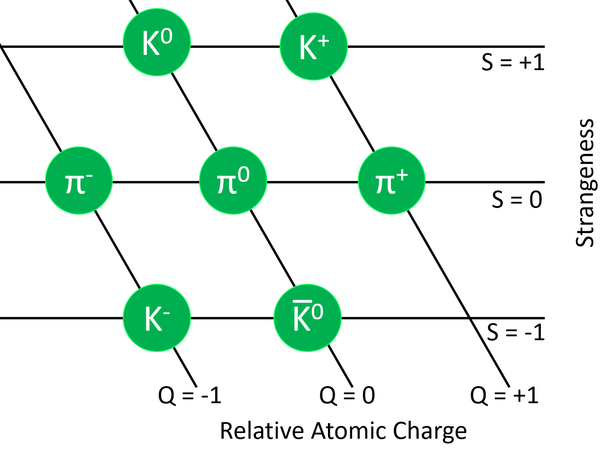Contents
Key Stage 5
Meaning
Mesons are a type of hadron consisting of a quark-antiquark pair.
About Mesons
- Mesons have a very short half life, decaying via the weak nuclear interaction or though the quark-antiquark pair annihilating one another.
- Mesons consisting of the quarks; up-quark, down-quark and strange-quark are divided into two main categories; π-mesons and k-mesons.
- K-mesons have a strangeness of +1 or -1. However, π-mesons do not carry strangeness.
- Mesons are affected by the:
Determining Meson Composition
NB: You do not need to memorise the exact composition of a given meson. However, you should be able to determine a possible quark composition given the charge and strangeness of the meson and by remembering the properties of the up-quark, down-quark and strange-quark.
- Mesons can be shown in the following diagram:
| The composition of these mesons can be determined given their charge and strangeness. |
Examples
| Quark | Charge/e | Strangeness |
|
Up-quark (\(u\)) |
\(q=+\frac{2}{3}\) | \(S=0\) |
|
Antiup-quark (\(\bar{u}\)) |
\(q=-\frac{2}{3}\) | \(S=0\) |
|
Down-quark (\(d\)) |
\(q=-\frac{1}{3}\) | \(S=0\) |
|
Antidown-quark (\(\bar{d}\)) |
\(q=+\frac{1}{3}\) | \(S=0\) |
|
Strange-quark (\(s\)) |
\(q=-\frac{1}{3}\) | \(S=-1\) |
|
Antistrange-quark (\(\bar{s}\)) |
\(q=+\frac{1}{3}\) | \(S=+1\) |
| Determine the composition of the π+ | Determine the composition of the K- |
|
π+ has a strangeness of 0, therefore it contains no strange-quark or antistrange-quark. π+ has a positive charge. This can be achieved with one charge of \(+\frac{2}{3}\)e (an up-quark) and \(+\frac{1}{3}\)e (an antidown-quark). Since \(+1 = +\frac{2}{3} + \frac{1}{3}\) Therefore \(π^+ = u + \bar{d}\) An up-antidown pair. |
K- has a strangeness of -1, therefore it contains a strange-quark. \(-1 = -\frac{1}{3} + x\) K- has a negative charge. This can be achieved with its strange-quark with a charge of \(-\frac{1}{3}\)e and another charge of \(-\frac{2}{3}\)e (an antiup-quark). Since \(-1 = -\frac{1}{3} + -\frac{2}{3}\) Therefore \(K^- = s + \bar{u}\) A strange-antiup pair. |
